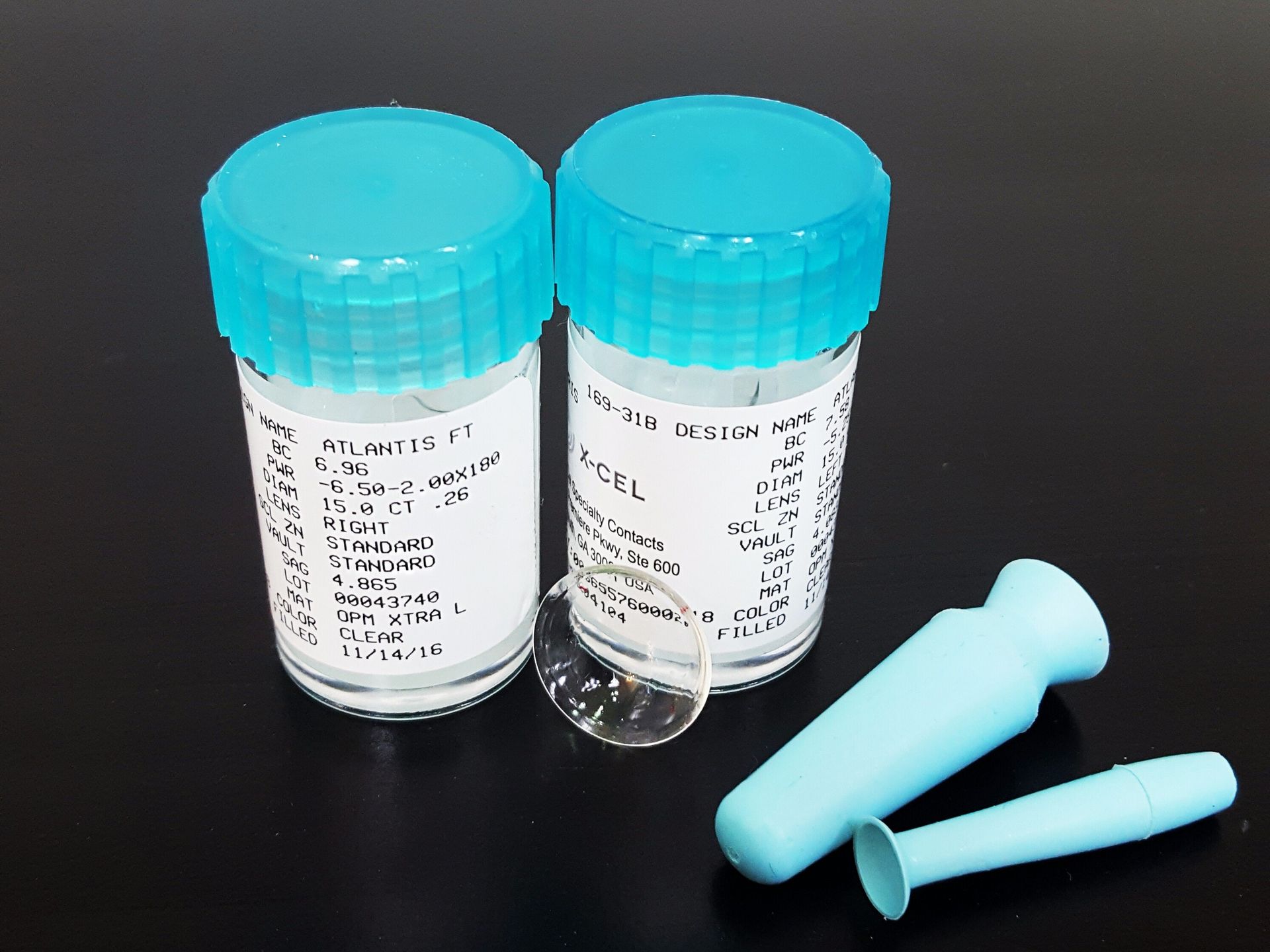Looking For Great Vision? Look No Further...Scleral Contacts Are Here!
Have you been told in the past that you weren’t a good candidate for contact lenses because of chronic dry eyes or a high astigmatism? Did you pay for refractive surgery only to have to wear glasses or contacts again? Ever wanted to be free from your glasses so badly that you decided to settle for less than ideal vision and comfort just to make it work? Or maybe you have an eye condition like keratoconus and just want to be able to see clearly regardless of if it’s in glasses or not? If any of these scenarios sound familiar you might be the perfect candidate for scleral contact lenses.
Sclera-what?
Scleral lenses are a large diameter contact lens made from a rigid gas permeable (RGP) material. Some of you may be familiar with the more conventional, smaller RGP lenses that can provide great vision but aren’t always very comfortable. Scleral contacts provide the crisp vision of a conventional RGP with the comfort of a soft contact lens - without the potential end of day dryness. How does one lens accomplish all of this? Keep reading to find out.
Comfort
Less Lens Awareness
As mentioned, scleral contact lenses can offer incredible comfort. This is due in large part to the size and design of the lens and how it rests on the eye. Unlike soft contact lenses and conventional RGP lenses that rest directly on the cornea, (the clear layer that covers the front of the eye) the scleral lens’ domed shape vaults over the cornea and instead rests on the sclera (the “white” of the eye). With the cornea being one of the most sensitive tissues on the body because of its high density of sensory nerve endings, it’s no surprise that having the lens instead rest on a less sensitive part of the eye results in increased comfort.
Reduced Dryness
Another area of relief that scleral lenses provide is from the discomfort of dry eyes. The space between the front of the eye and the back of the lens is filled with a tear layer that provides continuous moisture and lubrication directly to the cornea from the moment the lens is put on until it is taken off.
Improved Vision
Consistency
A common complaint of soft contact lenses is that the vision fluctuates throughout the day. This is because the clarity of soft contact lenses depends in large part on the moisture provided to your cornea and the lens by your tear system. This moisture can vary at different times due to environmental factors, computer usage, certain medications, or a dry eye condition. The result is blurred vision that comes and goes randomly during the day. Scleral lens wearers won’t experience this fluctuation in vision due to the above mentioned tear layer that bathes the cornea and keeps it lubricated for as long as the lens is worn.
Also, if you do happen to have a high astigmatism, keratoconus, or have had LASIK, instead of your cornea being a smooth rounded surface it might be more irregular - meaning it could have different levels of steep and flat areas (like a bumpy road) or it could be extremely steep (like the end of a football instead of round like a basketball). This makes correcting your vision - even through glasses - somewhat difficult. However, the design of scleral contact lenses provides you instead with a smooth, regular, viewing surface.Lens Stability
The larger diameter of scleral contacts means they will naturally move less on your eyes. The edges rest underneath the lid margins lending to very little possibility of the lens dislodging and coming out - which can sometimes happen with standard RGP’s. With this lessened movement also comes less visual disturbance, making for an all around better experience.
Reduced GlareAgain, since the lens is so much larger than standard RGPs or even soft contact lenses, this means the optic zone (the part of the lens directly in the center that contains your prescription) is also much larger. This combined with the increased stability of the lenses ensures the contacts stay centered over your pupil even at night when the eyes naturally dilate. Which, in turn, leads to crisper vision with lessened light reflections and starbursts.
Who Can Wear Scleral Lenses?
Technically anyone who would like optimum vision and comfort can try scleral contact lenses. You don’t have to have any special eye conditions to wear them. In fact, even athletes make great candidates since it is crucial that they have crisp stable vision without the worry of their lenses popping out, drying out, or having other complications. Additionally, there are several eye and health conditions that can greatly benefit from the usage of scleral lenses. These include:
- Keratoconus
- Regular and Irregular Astigmatism
- Dry Eye
- Stevens-Johnson Syndrome
- Chemical and Thermal Burn Injuries
- Sjogren’s Syndrome
- Graft Vs Host Disease
- post-LASIK Dry Eye
- Post Corneal Transplant
How Do You Get Started?
Still on board? You’ll need to have a recent eye health examination to make sure your eyes are healthy enough to wear contacts and to determine your prescription. From here you can make a contact lens fitting appointment where several measurements will be taken into account in order to narrow down the best size and optics for your new lenses. Also, keep in mind if you are over the age of 40 you might still need to wear glasses to help you with up close tasks.






